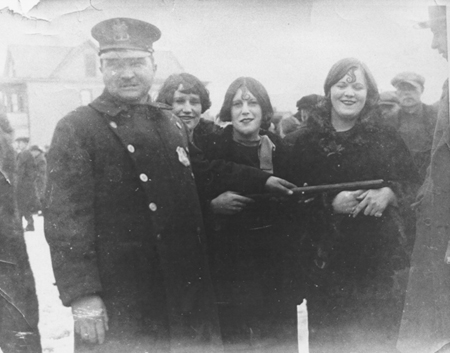|
Home
Notable Facts
Images
Documents
Material
Objects
E-Classroom
New Jersey Women's Heritage
Trail
Topical
Index
Bibliography
Webliography
Feedback
Search
| |

|
Striking Woolen Workers, Passaic, 1926
Courtesy, Emil Asher and American Labor Museum, Haledon, NJ.
This photograph shows young female woolen workers with
a police officer during the Passaic woolen strike of 1926. The friendliness of the pose
belies the conflicts between strikers and police and the numerous arrests of strikers. On
January 25, 1926, six thousand workers struck the Botany Mill in Passaic. The strike soon
spread to other mills in the neighboring towns of Garfield, Clifton, and Lodi. The
strikers' demands included abolition of a wage cut and an increase in wages, overtime pay,
a 44-hour work week, decent working conditions, and recognition of their union. By March,
over 15,000 workers were out on strike. The strikers defied attempts by the Passaic City Council to
prevent them from picketing, resulting in constant battles with the police and subsequent
arrests. All commentators agreed that women played a key role in the strike, whether as
pickets or through relief and child-care efforts. Sixteen-year old Martha Stone Asher, who
was responsible for chairing daily strike meetings at the Garfield headquarters, recalled
attempting to communicate with women who spoke many different languages including Polish,
Hungarian, German, Russian, and Italian. In late 1926 and early 1927, most of the mills
came to terms with the strikers, who had won the right to organize in Passaic.
|
|